
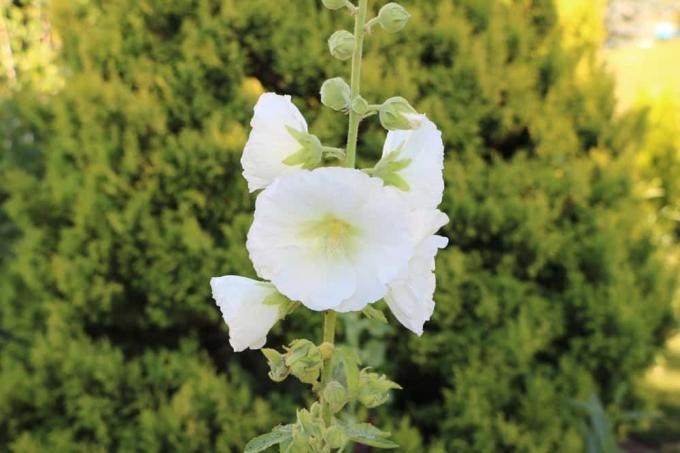
Table of contents
- What does two-year growth mean for the average?
- The perfect time
- Cut it right - that's how it works
- Cleaning prevents seeding
- Is Alcea rosea hardy?
- Instructions for wintering in the bed
- Overwintering hollyhocks in buckets - this is how it works
- Conclusion
Hollyhocks thrive as biennial or perennial summer flowers, which conjure up a romantic flair in your garden with their colorful calyxes. In the bucket, the picturesque beauties are a welcome guest on the summer balcony. Regardless of their name, peasant roses are not true roses, but are assigned to the mallow family. The herbaceous growth has a particular impact on cutting care and overwintering. Stop puzzling over the question of how to properly cut and overwinter your Alcea rosea. This guide has all the answers.
What does two-year growth mean for the average?
With their two-year growth, hollyhocks stand out among the summer flowers. Since this species-specific behavior has implications for pruning, we briefly summarize the characteristics of this floral life cycle below:
Hollyhocks have two vegetation periods between their growth as seedlings and the formation of seeds. In this respect, the term two-year growth is misleading, because it is not two calendar years. Before the climatically unfavorable winter time, the plants only develop their roots and a basal rosette of leaves. In this way, nutrient reserves are created for the second vegetation phase in the following summer. When the temperatures rise in spring, the stiffly erect stalk shoots out of the rosette of leaves, on which the flowers later unfold.
As a rule, biennial plants die after the seeds have ripened. As these instructions explain in more detail, this is not necessarily the case with hollyhocks. At least the unfilled varieties can bloom as often as perennials after a competent cut in the following years.
The perfect time
As the description of the two-year growth behavior shows, the basal leaf rosette has an important task in the year of planting. Cutting off the leaves before the onset of winter usually means that there will be no flowering at all in the following year. Hollyhocks remain unmolested by the scissors in the first year.
The best time to prune a peasant rose is from the second year after the end of the flowering period. The less energy an Alcea rosea has to invest in the strenuous formation of seeds, the better the prospects for another blossom festival next summer.
Tip:
Hollyhocks are completely non-toxic and do not have any sharp thorns like many real roses. Alcea rosea are therefore perfectly suited to transforming the family garden into a summery sea of flowers.
Cut it right - that's how it works
Hollyhocks make it easy for your gardener to trim them professionally. At the end of the flowering period, the strong stalk is cut off along with the withered inflorescences. Under normal weather conditions, this is the case in September or October. How to do it right:
- Use sharp, clean scissors or a freshly sharpened knife
- Grasp and stabilize the stem with one hand
- With the other hand, cut off the main shaft
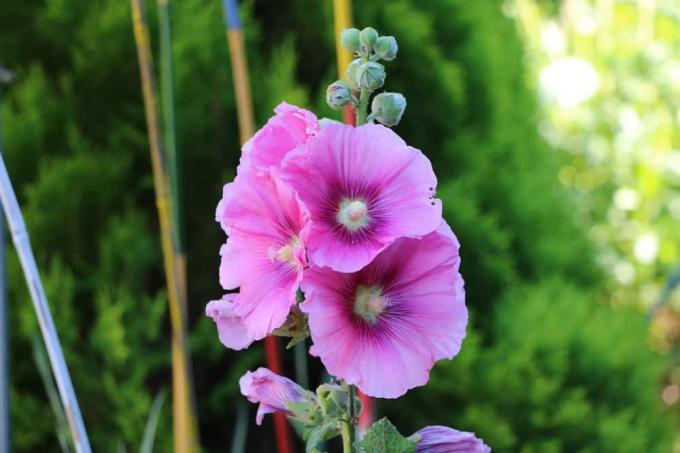
Ideally, make the cut just above the leaf rosette. This remains as natural winter protection until early spring. In February, cut off the unsightly, drawn-in leaves close to the ground to make room for fresh shoots.
Cleaning prevents seeding
Alcea rosea's propagation strategy focuses on self-seeding. For this purpose, the magnificent, pollinated calyxes turn into split fruits with countless seeds after they have faded. Where these fall on fertile soil, the leaf rosettes often grow in the same year, from which further farm roses later rise. Such an invasive urge to spread is not always in the gardener's best interests. How to effectively prevent seeding:
- Remove faded flowers from the stem as early as possible
- To do this, grasp the hairy flower stalk with your fingers
- Bend to the side and do not tear off
- Alternatively, use small scissors to cut off the flower stalk
Since the hollyhock opens its flowers successively from bottom to top, a hasty cut of the main stem removes a large number of unopened buds and radically shortens the flowering period. It is therefore worth cleaning out every single flower if self-sowing is undesirable in the garden.
Tip:
On hollyhocks in the bucket on the balcony, time-consuming cleaning of withered flowers can be omitted, provided the dried petals do not impair the appearance. Here it is quite sufficient to cut off the stem in autumn.
Is Alcea rosea hardy?
Anyone who has been able to enjoy the lavish abundance of blooms of hollyhocks for a summer will no longer want to do without the magnificent flowers in beds and tubs. So the question of winter hardiness is obvious. The specialist trade praises Alcea rosea as a plant in winter hardiness zone Z3. This assignment implies a basic frost hardness between -34.5 and -40.1 degrees Celsius.
Whether your hollyhocks actually survive severe frost unscathed depends on the local site conditions in your garden. The winter hardiness of rustic roses suffers noticeably in wind-exposed locations or in compacted, moist soil. Likewise, a sudden drop in temperature from plus to minus degrees of more than 10 degrees Celsius can undermine winter hardiness.
Furthermore, winter hardiness only refers to the rootstock, which is deep in the ground. The herbaceous plant parts on the surface die off completely after the first frosty nights. In contrast, the leaf rosette is better equipped for the cold as a shoot section.
Instructions for wintering in the bed
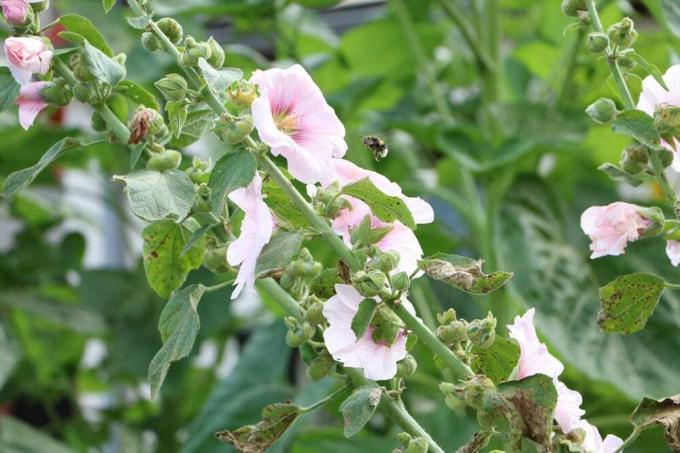
In order for the leaf rosette to hibernate healthy in the year of planting, it should receive a light winter protection in late autumn. This also benefits the taproots, which sometimes do not reach deep enough so shortly after planting to withstand severe frosty nights. In rough winter locations, these precautions are also useful in the following years:
- In the year of planting, cover the root disk and leaf rosette with leaves and brushwood
- Proceed in the same way in the following years after pruning in autumn
- Alternatively, cover the planting site with breathable and translucent fleece
Since the basal rosette continues to evaporate water during the cold season, the plant is threatened by drought stress in the event of a frost. Therefore, during a dry winter without snow and rain, water your hollyhock rosettes on mild days.
Tip:
Fertilizing with potassium-rich comfrey manure at the end of July/beginning of August strengthens the winter hardiness of hollyhocks. Potassium lowers the freezing point in the cell water and strengthens the cell walls against the stresses caused by repeated changes between thawing and freezing weather.
Overwintering hollyhocks in buckets - this is how it works
The categorization as a hardy plant down to - 40.1 degrees Celsius only applies to hollyhocks that have been planted out. These drive a deep-reaching taproot into the ground, which protects them from the biting frost. In the bucket, the root ball of your rustic roses is defenseless behind the relatively thin walls of the winter cold. Ideally, you should therefore move hollyhocks in pots to a frost-free, bright winter quarters after pruning. With the following measures, you can overwinter Alcea rosea correctly on the balcony:
- After pruning, place the bucket in front of a protective house wall
- Push in a block of wood or insulating styrofoam plates
- Cover the pot with fleece, jute or foil
- Cover the leaf rosette and the substrate with brushwood and leaves
- Water the root ball from time to time in winter so that it does not dry out
In harsh winter locations with pronounced wind exposure, prudent gardeners build a protective winter quarters for their hollyhocks in tubs. For this purpose, the bottom of a large wooden box is lined with bark mulch or leaves. The bucket with the peasant rose is placed on top of it.
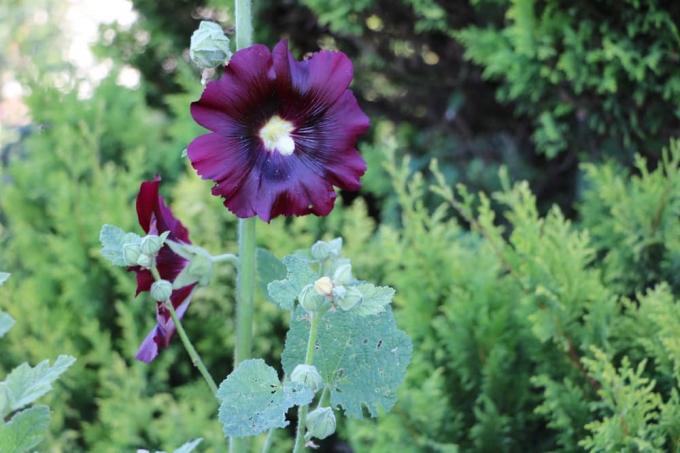
The free space between the pot and the wooden wall is filled with the remaining mulch. As soon as the night-time temperatures no longer fall below freezing in spring, the winter protection is removed or a bucket cleared out.
Conclusion
Pruning hollyhocks properly is not difficult, even for the novice gardener. In the first year, the biennial plant forms a basal rosette of leaves that is not cut. The scissors are only used in the second year, at the end of the flowering period, by simply cutting off the strong, faded stalk just above the base rosette. Regular cleaning of withered flowers during the flowering period effectively prevents the annoying spread of self-seeding. If this pruning is heeded, rustic roses will bloom again in the years to come and will not be satisfied with a single rendezvous in the summer garden. A light winter protection guides Alcea rosea through the cold season unscathed in the first year. In locations with harsh winter conditions, the root disc will be covered with leaves and brushwood after pruning in the years to come. For hollyhocks in tubs, the classification as a hardy plant only applies to a limited extent. Without the precautions recommended here, hopes for sustained growth will come to nothing.
 garden editorial
garden editorial I write about everything that interests me in my garden.
Learn more about pruning

Eucalyptus dried up: cut back now?
When a eucalyptus dries up, some owners immediately think of cutting it back. Because they want to see fresh green bud quickly. The chances of that happening may be good. But one thing must not be left out: research into the causes! Otherwise a new cycle of drying up and cutting begins.
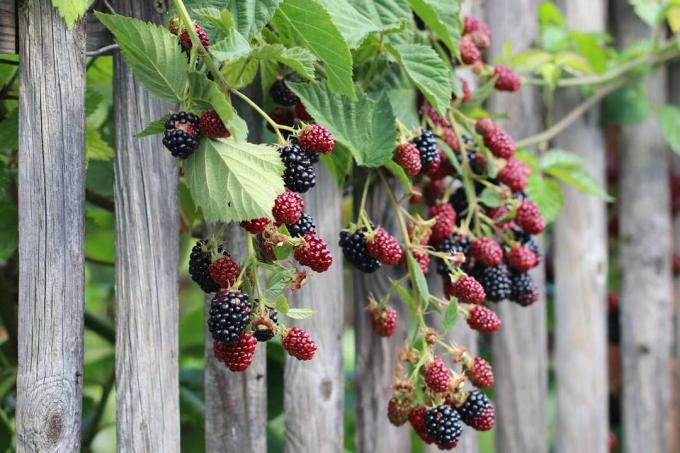
Cut blackberries: Instructions for the right cut
Bramble branches only bear fruit for one summer, after which they are used up and die off in winter. It's a good thing that new canes grow back in time for the following year. Cutting care means: What no longer supports should be removed, young rods must be optimally trained.

cutting snowball | 13 tips for pruning
When it comes to snowballs (Viburnum), the opinions of numerous hobby gardeners differ when it comes to cutting. Main reason against pruning: Destruction of the natural appearance by pruning. Find out now when it is unavoidable and which tips should be heeded.

Cutting sage: 6 tips for cutting back
Cutting measures and their ideal time depend on the species of sage plants, because they have differentiated ways of life. There are woody and herbaceous representatives that require different attention. In order to carry out the measures, a basic set of tools is helpful.

Pruning hydrangeas: when is the right time?
Hydrangeas are a real beauty because of their flowers. In the long term, however, the flowering power is only maintained if regular pruning takes place. Because cutting off withered or dried plant parts offers protection. The following guide shows when this measure should be taken.
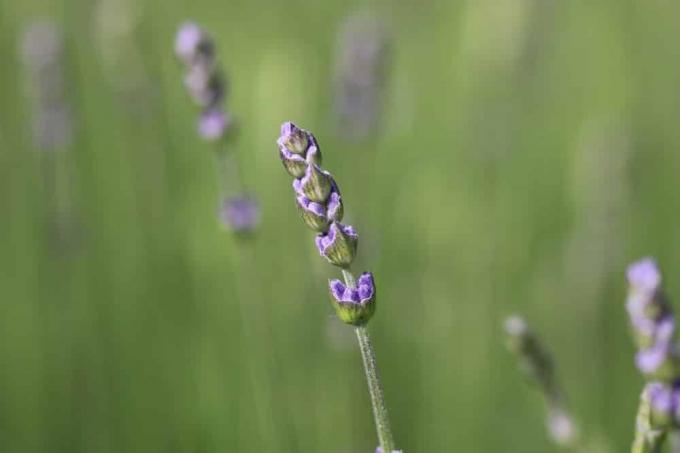
Cutting Lavender | When is the best time?
Lavender is a popular perennial, but difficult to cut. Without regular pruning, the shrub becomes lignified and less robust. Choosing the right time is important for pruning. When to cut depends on the use of the perennials.

